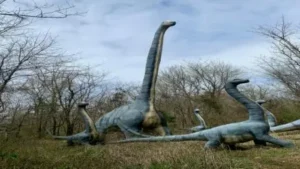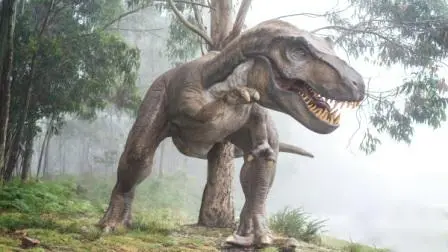Introduction:
Fascinating chapters in the vast expanse of Earth’s history wait to be uncovered. One such chapter takes us back a staggering 167 million years, introducing us to Tharosaurus indicus, the oldest long-necked dinosaur ever discovered in India. This monumental find not only sheds light on the ancient past but also underscores India’s pivotal role in the evolution of these magnificent creatures.
The world of paleontology has always held an allure, a promise of unveiling the secrets of a time long gone. Fossils are the imprints of prehistoric lives, whispers from the depths of history. And within the ancient rocks of India’s Thar Desert, a team of dedicated researchers embarked on a journey that would rewrite the narrative of Earth’s distant past. Here, under the scorching sun, they meticulously unearthed the fossilized remains of Tharosaurus indicus, a creature that once roamed the lush landscapes of the Middle Jurassic period.

Dinosaur Discovery: The Jurassic Journey of Tharosaurus Indicus
Deep in the heart of India’s Thar Desert, near the enchanting city of Jaisalmer in Rajasthan, a team of intrepid researchers embarked on an extraordinary journey into the annals of Earth’s history. With the scorching sun beating down and the desert winds whispering tales of bygone eras, they meticulously unearthed the fossilized remains of Tharosaurus indicus. This plant-eating giant reptile once roamed our planet during the Middle Jurassic period, a time when dinosaurs ruled the Earth.
The significance of this discovery cannot be overstated. Tharosaurus indicus is a window into an epoch when Earth was a vastly different place. It was a time when continents were still taking shape, and life was undergoing remarkable transformations. Dinosaurs like Tharosaurus indicus were the architects of a world dominated by reptilian majesty.
The excavation site, nestled near the city of Jaisalmer, was not chosen by chance. This region was once part of a shoreline along the prehistoric Tethys Ocean, a massive body of water that has long vanished from our planet’s surface. The very ground on which Tharosaurus indicus was found holds clues to the geological history of India and the vast changes it has undergone through eons.
Dinosaur Evolution: The Rise of Dicraeosaurids:
Tharosaurus indicus belongs to an extraordinary group known as dicraeosaurids. What sets these dinosaurs apart are their elongated necks, a testament to nature’s creativity in adaptation. These magnificent creatures were gentle giants, their lives intricately entwined with the lush vegetation that surrounded them.
The dicraeosaurids are a fascinating branch in the grand tree of dinosaur diversity. These long-necked herbivores evolved specialized adaptations to reach and consume vegetation high above the ground. They were nature’s architects, sculpting the landscapes they inhabited with their unique feeding habits.
The discovery of Tharosaurus indicus is a momentous occasion for paleontology. It’s not merely the oldest of its kind found in India; it’s the oldest dicraeosaurid in the entire world. This revelation elevates India’s significance in the annals of dinosaur evolution to new heights. It suggests that the subcontinent was not only a habitat but also a crucible. Here, new dinosaur species and adaptations were forged, adding to the richness of Earth’s ancient history.
India’s Role in Dinosaur Evolution:
The unearthing of Tharosaurus Indicus has profound implications for our understanding of dinosaur evolution. It reinforces the notion that India played a significant role in the grand tapestry of prehistoric life. The Indian subcontinent, which we know today, was once part of a much larger landmass during the time of Tharosaurus indicus.
During the Middle Jurassic period, when Tharosaurus indicus roamed the Indian landscape, India was situated closer to the South Pole. The climate was vastly different from what we know today, marked by lush forests and waterways. It was in this ancient Indian landscape that Tharosaurus indicus thrived, an embodiment of the rich biodiversity of its time.
The discovery of Tharosaurus indicus also prompts us to reconsider the ancient connections between continents. While we have well-documented India’s journey across the oceans to collide with Asia, it’s essential to remember that during the Jurassic period, continents were in motion. India’s position was different, and it played a unique role in the dispersal and evolution of life forms.
Tracing Tharosaurus’s Origins:
Scientists, driven by curiosity, have speculated that the dicraeosaurid group, to which Tharosaurus indicus belonged, may have originated in India. This hypothesis opens a window into the past, suggesting that India was not just a destination for dinosaur evolution but possibly the very cradle of their existence.
This theory, though tantalizing, still stands on the precipice of discovery, awaiting further confirmation. To delve deeper into the enigmatic past of Asian dinosaurs, researchers are studying other specimens, like the Lingwulong, a dinosaur from the Middle Jurassic period. Comparative analysis of these fossils may offer crucial insights into the origins and dispersal of these majestic creatures.
The Lingwulong, also a long-necked dinosaur, shares certain similarities with Tharosaurus indicus, hinting at the interconnectedness of prehistoric life. It’s a piece of the puzzle, and as we study these ancient beings, we draw closer to understanding the intricate web of life on Earth during the Jurassic period.
A Global Puzzle:
Regions like Africa, South America, the United States, and China have unearthed the majority of dicraeosaurids from the Middle Jurassic to Early Cretaceous periods, but Tharosaurus indicus presents a unique piece in the global dinosaur puzzle. Its distinct features, including long neck depressions and unique neural spines, hint at a dinosaur with a story unlike any other.
Tharosaurus indicus is a testament to the diversity of dinosaur species on our planet. Each discovery, every fossil, enhances our understanding of these ancient giants, adding complexity to their story. The uniqueness of this find challenges researchers to reassess their assumptions about the distribution of dicraeosaurids across the continents.
What’s particularly intriguing is the fact that Tharosaurus indicus seems to have had distinct adaptations. The long depressions on the sides of its neck bones and the unique neural spines suggest that it possessed features not seen in its counterparts from other parts of the world. These adaptations were likely a response to its specific environment and the challenges it faced in the ancient Indian landscape.
Lessons from the Past:
The discovery of Tharosaurus indicus serves as a poignant reminder of the importance of exploring older fossil sites in India. As our understanding of Earth’s history deepens, it becomes evident that India’s landscapes have been witnesses to an astonishing array of ancient life forms.
This discovery underscores the need for continued research and preservation efforts. It beckons scientists and enthusiasts to delve deeper into the sands of time. They unearth the remnants of creatures that roamed the Earth. The lessons from the past inform our understanding of the present and our responsibility to safeguard biodiversity on our planet.
India, with its diverse ecosystems and ancient geological history, holds the keys to unlocking countless more secrets of the past. The Thar Desert, especially, holds a treasure trove of fossils. It’s a testament to the rich tapestry of life that unfolded on this subcontinent for millions of years.
Conclusion:
As we gaze at the remarkable fossils of Tharosaurus indicus, we stand on the precipice of the past. It reminds us of India’s rich history in paleontology. This ancient giant, with its long neck and unique features, adds layers to the ever-evolving narrative of Earth’s prehistoric inhabitants.
Tharosaurus indicus expands our understanding of dinosaurs and emphasizes the need to preserve and explore the treasures hidden beneath the sands of time. This discovery reaffirms India’s role in the story of dinosaur evolution. It reminds us that our planet’s history weaves a tapestry filled with threads of wonder and discovery. The legacy of Tharosaurus Indicus invites us to unravel the mysteries of our past and cherish Earth’s extraordinary biodiversity.
It calls upon us to be stewards of our planet’s heritage. We must ensure that the lessons of the past guide us toward a sustainable future. In this future, the wonders of nature endure, and knowledge and conservation walk hand in hand.
Also read : India’s Economic Growth | Infrastructure Investments Fuel








